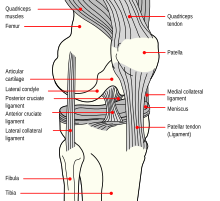
Back إصابة الرباط الصليبي الأمامي Arabic Riss des vorderen Kreuzbandes German Ρήξη προσθίου χιαστού συνδέσμου Greek Lesión del ligamento cruzado anterior Spanish آسیب رباط صلیبی پیشین Persian Eturistisiteen vamma Finnish פציעה ברצועה הצולבת הקדמית HE Ozljeda prednjeg križnog ligamenta Croatian Առաջային խաչաձև կապանի վնասվածք Armenian 前十字靭帯損傷 Japanese
| Anterior Cruciate Ligament injury | |
|---|---|
 | |
| Diagram of the right knee | |
| Specialty | Orthopedics |
| Symptoms | Audible "crack" with pain, knee instability, swelling of knee[1] |
| Causes | Non-contact injury, contact injury[2] |
| Risk factors | Athletes, females[1] |
| Diagnostic method | Physical exam, MRI[1] |
| Prevention | Neuromuscular training,[3] core strengthening[4] |
| Treatment | Braces, physical therapy, surgery[1] |
| Frequency | c. 200,000 per year (US)[2] |
An anterior cruciate ligament injury occurs when the anterior cruciate ligament (ACL) is either stretched, partially torn, or completely torn.[1] The most common injury is a complete tear.[1] Symptoms include pain, an audible cracking sound during injury, instability of the knee, and joint swelling.[1] Swelling generally appears within a couple of hours.[2] In approximately 50% of cases, other structures of the knee such as surrounding ligaments, cartilage, or meniscus are damaged.[1]
The underlying mechanism often involves a rapid change in direction, sudden stop, landing after a jump, or direct contact to the knee.[1] It is more common in athletes, particularly those who participate in alpine skiing, football (soccer), netball, American football, or basketball.[1][5] Diagnosis is typically made by physical examination and is sometimes supported by magnetic resonance imaging (MRI).[1] Physical examination will often show tenderness around the knee joint, reduced range of motion of the knee, and increased looseness of the joint.[2]
Prevention is by neuromuscular training and core strengthening.[3][4] Treatment recommendations depend on desired level of activity.[1] In those with low levels of future activity, nonsurgical management including bracing and physiotherapy may be sufficient.[1] In those with high activity levels, surgical repair via arthroscopic anterior cruciate ligament reconstruction is often recommended.[1] This involves replacement with a tendon taken from another area of the body or from a cadaver.[2] Following surgery rehabilitation involves slowly expanding the range of motion of the joint, and strengthening the muscles around the knee.[1] Surgery, if recommended, is generally not performed until the initial inflammation from the injury has resolved.[1] It should also be taken into precaution to build up as much strength in the muscle that the cadaver is being taken from to reduce risk of injury[clarification needed].
About 200,000 people are affected per year in the United States.[2] In some sports, women have a higher risk of ACL injury, while in others, both sexes are equally affected.[5][6][7] While adults with a complete tear have a higher rate of later knee osteoarthritis, treatment strategy does not appear to change this risk.[8] ACL tears can also occur in some animals, including dogs.
- ^ a b c d e f g h i j k l m n o p "Anterior Cruciate Ligament (ACL) Injuries". OrthoInfo. American Academy of Orthopaedic Surgeons - AAOS. March 2014. Archived from the original on 5 July 2017. Retrieved 30 June 2017.
- ^ a b c d e f "ACL Injury: Does It Require Surgery?". OrthoInfo. American Academy of Orthopaedic Surgeons (AAOS). September 2009. Archived from the original on 22 June 2017.
- ^ a b Hewett TE, Ford KR, Myer GD (March 2006). "Anterior cruciate ligament injuries in female athletes: Part 2, a meta-analysis of neuromuscular interventions aimed at injury prevention". The American Journal of Sports Medicine. 34 (3): 490–8. doi:10.1177/0363546505282619. PMID 16382007. S2CID 25395274.
- ^ a b Sugimoto D, Myer GD, Foss KD, Hewett TE (March 2015). "Specific exercise effects of preventive neuromuscular training intervention on anterior cruciate ligament injury risk reduction in young females: meta-analysis and subgroup analysis". British Journal of Sports Medicine. 49 (5): 282–9. doi:10.1136/bjsports-2014-093461. PMID 25452612.
- ^ a b Prodromos CC, Han Y, Rogowski J, Joyce B, Shi K (December 2007). "A meta-analysis of the incidence of anterior cruciate ligament tears as a function of gender, sport, and a knee injury-reduction regimen". Arthroscopy. 23 (12): 1320–1325.e6. doi:10.1016/j.arthro.2007.07.003. PMID 18063176.
- ^ Montalvo AM, Schneider DK, Yut L, Webster KE, Beynnon B, Kocher MS, Myer GD (August 2019). "'What's my risk of sustaining an ACL injury while playing sports?' A systematic review with meta-analysis". British Journal of Sports Medicine. 53 (16): 1003–1012. doi:10.1136/bjsports-2016-096274. PMC 6561829. PMID 29514822.
- ^ Williams, Sally (14 September 2024). "'Everyone says they hear a pop or a crack': why are so many female footballers suffering career-ending knee injuries?". The Guardian.
- ^ Monk AP, Davies LJ, Hopewell S, Harris K, Beard DJ, Price AJ (April 2016). "Surgical versus conservative interventions for treating anterior cruciate ligament injuries". The Cochrane Database of Systematic Reviews. 2016 (4): CD011166. doi:10.1002/14651858.CD011166.pub2. PMC 6464826. PMID 27039329.